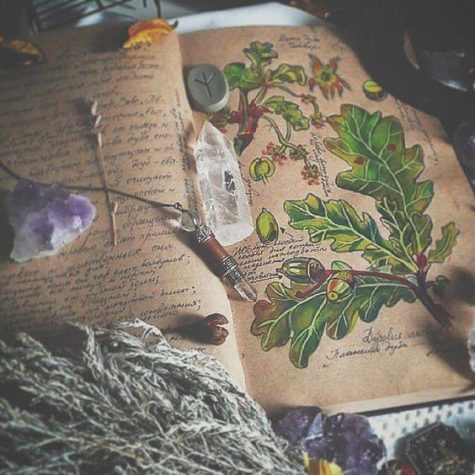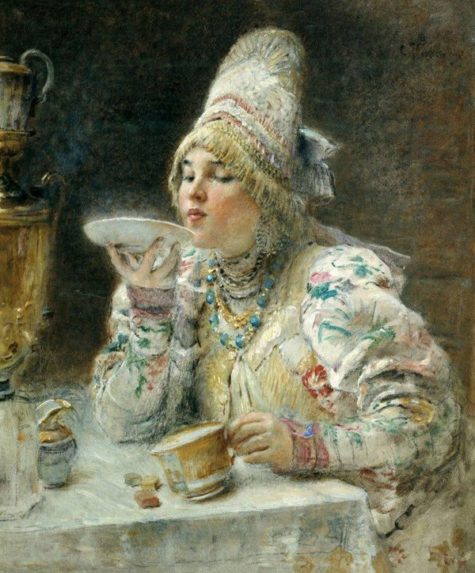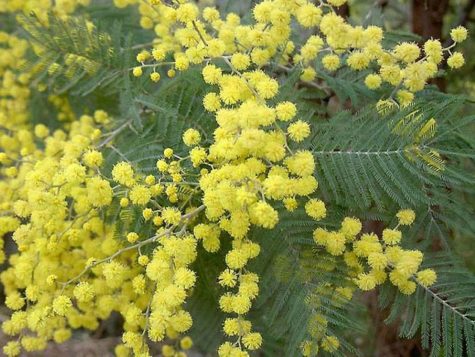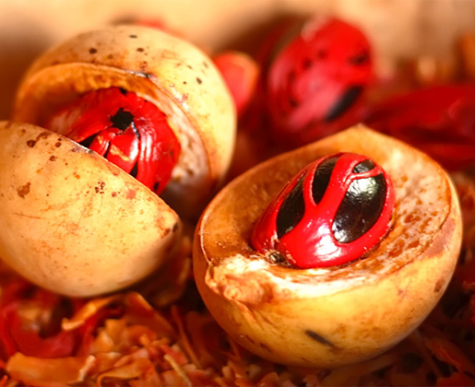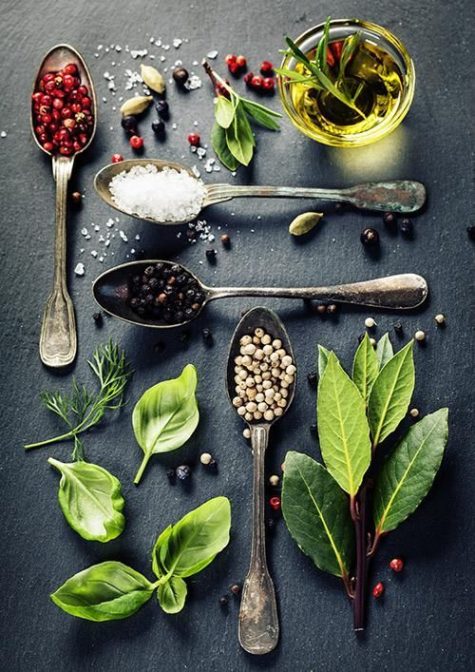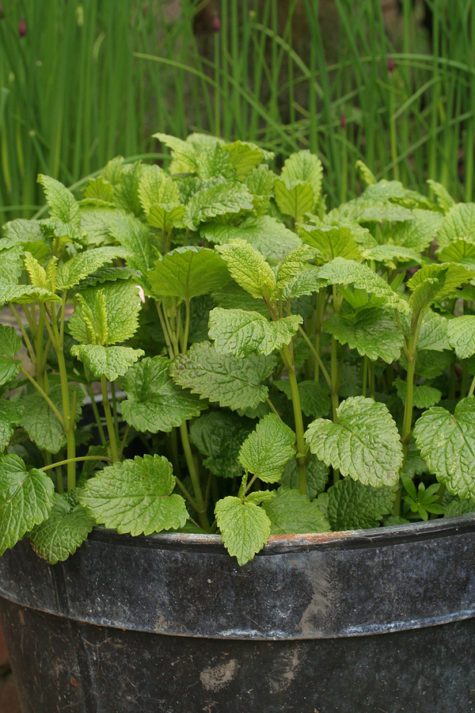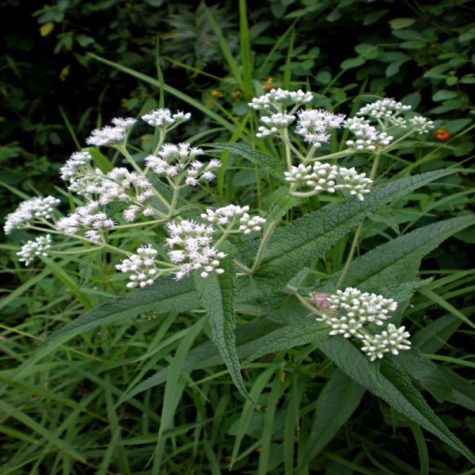Herbs and Spices
- Angelica:
Angelica was linked sometimes with St. Michael the Archangel and was even called “The Root of the Holy Ghost”. It protects against witchcraft, evil spirits, spells and enchantments.
- Basil (Sweet):
Basil is believed to have derived its name form the Basilisk, the fabulous dragon-like creature that was deadly to anyone who looked at it. This may have spawned the old belief that Basil begot scorpions.
- Betony (Wood):
Betony, the original herb of Magic and medicine discovered by Chiron the Centaur. Cured against ‘elf sickness’. Believed that animals seek it out when ill. Old lore says that if two snakes are put into a ring of Betony, they will fight to the death. Considered magically powerful against evil spirits.
- Bistort:
The word bistort means ‘twice twisted’. The twisted root resembles a snake. English names include snakeweed and adderwort. Regarded as a cure for snake bites. Lore also says that this herb can help a woman conceive a child.
- Blackberry:
Blackberry was considered to be a holy plant. In the Highlands, they’re called Blessed Brambles. If twined into a wreath with rowan and ivy, will keep away evil spirits. Brambles or alternatively osieres, would be plaited around a grave to keep a ghost from rising. Believed that Christ used a bramble to drive the money changers out of the temple and to spur his donkey onto Jerusalem. Thought to cure various ailments if the sick would walk under an archway of bramble rooted at each end.
- Broom:
A piece of broom is worn in a cap because its ancient reputation as a plant both useful to witches and against them. Was also used as a magic sleep enhancer and as a power in love spells.
- Byrony (White):
White Byrony is used in place of European Mandrake root. Helped in fertility spells for barren women. Also called Womandrake and related to the Yam family. In France was called “Herb of Beaten Wives” because the berry juice resembles the black and blue marks of beatings.
- Centaury:
Discovered by Chiron the Centaur. Centaury was used to cure fevers. Was considered to be another powerful herb against Witchcraft and Magic.
- Chicory:
Chicory was believed to be a cure for failing sight and poor eyes because its flowers only open during sunlight. If gathered by a special ritual, it was believed to make one invisible and also open locked doors and chests. To do so, one must cut the plant with a gold blade on St. Jame’s Day, July 25.
- Cinquefoil (Potentilla):
Cinquefoil meant “small and powerful”. Hung in doorways to keep out evil spirits. A main ingredient in Witch potions and ointments.
- Devil’s Bit (Scabious):
Old lore says that the Devil bit it for envy because the herb had so many good virtues and was so good for mankind. In Cornwall England, was referred to as Devil’s Button and to pick the plant one was sure to receive a nocturnal visit from the Devil.
- Dill:
Dill was known as an anti-witch plant. Was used to lull people into stupors and thus mothers used it on their babies to keep them sleepy. Used in and against spells.
- Eyebright:
St. Michael used it along with rue and three drops from the Well of Life to anoint his hurt eyes after his battle with the Devil and the latter’s fall.
- Fennel:
Fennel has genuine wind-expelling properties. Used to keep evil spirits away especially on Midsummer’s Eve when it would be hung with St. John’s Wort over doorways. Keyholes blocked with fennel would keep out ghosts. Was also believed to confer longevity and improve strength and courage.
- Foxglove:
Foxglove was associated with fairies and elves as they gave gloves to the fox so he could raid the chickens and escape harm. Said that if the fairies wore these ‘gloves’ they could do anything. Was believed to be dangerous to cut foxglove but once you’d done so and lived it was a good defense against the little people.
In Wales it’s juice was rubbed into a floor in the shape of a cross to protect the home from the fey folk. It could also be used to kill a changeling child. Also believed that the souls of the dead inhabited the flowers thus the alternate names of ‘bells’, ‘thimbles’ or ‘deadman’s fingers’.
- Mugwort:
Known alternatively as St. John’s Herb and Mugwort was considered to be the “Mother of Al Herbs.” Some believed that St. John the Baptist wore a girdle of Mugwort in the forest where he lived. Was cured in the Midsummer bonfires and hung up over doorways to keep evil at bay. Also used to keep travelers from getting too weary.
- Orchid:
Orchid, another name for Satyrion root which was believed to be a powerful aphrodisiac. Men and women ate the tubers as sexual stimulants and in the hopes of defining what sex a newborn would take.
- Parsley:
Parsley was not originally considered an herb but rather in connections with both ‘noble’ and ‘funeral’. The Greeks strewn it on graves. It was used on food plates as a garnish as an antidote to poison and thus put on a plate was considered a token of trust. It was also thought if a man ate some of the seeds prior to drinking he’d be able to drink more and still retain his faculties.
- Peony:
The Peony was regarded as having a divine origin. Sacred to Peon, physician to the Gods. Would protect from evil spirits and storms and would in particular protect shepherds and their flocks, farmers and their crops. Was considered as dangerous as Mandrake to dig up and thus the same kinds of protections must be used. It was also believed to be highly dangerous to dig up if a woodpecker was nearby as the gatherer of the herb would lose his sight.
- Plantain:
Plantain was known as ‘healing herb’ in Scotland and Ireland. Was considered a very powerful plant since it could stand back up against the boot heel or chariot wheel crushing it down. Due to this belief, it was used to treat wounds and bruises.
- Rosemary:
Rosemary was dropped into coffins as a way of letting the dead know that you’d not forget them. Also very protective against physical injury and thunder and or lightning. Could renew youth and help ‘special’ enterprises to grow and succeed.
- Sage:
Sage has an ancient reputation as a healing plant and thought to confer long life. Tradition says that if the plant lives or dies so will a business owner’s livelihood thrive or fail.
- Solomon’s Seal:
Solomon’s Seas is said to bear a symbol on its roots, the two interwoven triangles which make up the hexagram, will scare off evil spirits! The white flowers were used in love potions and the plant was used to help ‘knit bones’ together.
- Tarragon:
Also known as Little Dragon, Tarragon is reputed to have sprung up where the banished serpent from the Garden of Eden brushed up over the ground along with Mugwort and Wormwood. Since Dragons were both terrifying and protective, it was believed to cure snake-bite.
- Viper’s Bugloss:
The seeds of this herb resemble a viper’s head and thus thought to be another cure against snake bite.
- Yarrow:
Yarrow, also known as Bloodwort is noted for its wound healing powers and was regarded as another herb dedicated to the Devil.
Collected from various sources
To prepare herbal tea, use approximately one to three teaspoons of herb per cup of boiling water. Boil water but do not use an aluminum kettle. Pour water into a mug or pot leaving herbs to steep for at least five minutes, but don’t leave for longer than ten minutes or the tea may become bitter. For stronger tea, use more herb rather than steeping the tea for a longer time.
Store herbal tea in amber colored or opaque jars, never in clear glass jars. The potency of the herb may be destroyed by light. Mild teas can be used daily over long periods of time with no ill effects.
- Anise: Protection, purification, awareness, joy, calling Spirits.
- Basil: Protection, love, healing relationships, courage, fertility, exorcism. Calming the nerves.
- Bergamont: Success
- Burdock Root: Purity, Protection
- Caraway: Protection, passion. Has the power to prevent the theft of any object that contains the seed and to keep lovers from losing interest in one another.
- Catnip (flavor with mint): Peace.
- Chamomile: Love, Relaxation. Calming, Mediation
- Cinnamon: Spiritual quests, augmenting power, love, success, psychic work, healing, cleansing.
- Clove: Dispels negativity, protection, draws money, defrays gossip, vision, cleansing.
- Comfrey: Safe travel, draws money, healing.
- Dandelion: Divination, welcoming, messages.
- Elder Flower: Divination
- Eyebright: Mental and Psychic Power
- Fennel: Purification, protection, healing, money.
- Ginger: Protection. Power, success, love, money. (place a few slices of fresh ginger in boiling water).
- Ginseng: Love, wishes, beauty, desire.
- Hyssop: Purification
- Lemon: Purification, love, blessings.
- Lemon (Leaves): Lust
- Lemon Balm: Health, Success
- Licorice Root: Love and Sex. (boil licorice root)
- Mint, Spearmint, Peppermint: Draws money, healing, strength, augments power, purification, luck, safe travel.
- Mugwort: Divination
- Mullein: Divination
- Nettle: Averts danger, protection, healing. Use gloves to handle so as to avoid getting pricked.
- Rose Hips: Psychic Power and Divination
- Rose Hips and Hibiscus: Love, friendship, luck, protection, psychic power and divination.
- Rosemary: Improves memory, sleep, purification, youth, love, power, healing, protection, intellectual.
- Sage (sweetened with honey): Long life. Fertility, wishes, wisdom, protection.
- Thyme: Sleep, psychic energy, courage, healing. Use both the leaves and flowers.
- Valerian: Love, calming, sleep. Gets fighting couples together.
- Yarrow: Courage, love, psychic abilities, divination. The tea drunk prior to divination will enhance one’s powers of perception (a touch of added peppermint enhances its action).
- Ruler: Zeus, Obatala, Ra, Bast, solar deities
- Type: Plant
- Magickal form: oil, bark, branch, flower
- Other names: Cassie Flower, Catechu, Egyptian Thorn, Gum Arabic, Cape Gum
- Basic powers: Protection, Clairvoyance
Acacia is much revered in religious and magickal practice as an emblem of immortality and of initation, in the sense that initiation is symbolic of resurrection. The ancient Egyptians made funeral wreaths of Acacia leaves and the Hebrews planted a sprig of evergreen Acacia to mark the grave of a departed friend.
Carry the wood as a protective amulet.
Acacia wood is the Biblical shittim-wood from which Noah’s Ark and the Tabernacle and Altar wer made. Jewish legend tells us that the Burning Bus of Moses was an Acacia. Christian lore links an Acacia tree with the Cross and its spiny branches with the Crown of Thorns. The sap of some spiny Acacia species yields Gum Arabic, used as a binding agent.
Sitting under an acacia tree or burning the dried flowers brings wisdom and insight. The oil extracted from the plant is considered holy and used for purification and anointing. It is especially powerful when attempting to contact the dead and should be rubbed into white candles and not worn on the body while attempting such work. For personal anointing, mix with other oils (like musk or camellia) to cut and then it is said to bring happiness.
- To contact the dead:
Dip acacia leaves in holy water and sprinkle an altar with the water, or burn Acacia as incense to communicate with or to memorialize the dead.
- To open the mind to visions:
Acacia leaves are burned on charcoal to induce spiritual phenomena and develop personal psychic power; adding Frankincense and Myrrh is used to intensify the effect.
Mace is a spice made from the waxy red covering which covers nutmeg seeds. It is completely different from the protective pepper spray with the same name.
Mace is produced by, Myristica franrans, a member of the mayriticaceae family. This plant, native to Indonesia, grows into a tropical evergreen tree of up to thirty feet tall.
Mace is actually the aril of the nutmeg seed shell. It is removed from the shell. The broken part of it is generally known as blades. Nutmeg and mace are treated separately. But the history of both of them is related to each other. The color of mace can be different from one to another place. The mace from West Indies is generally yellowish brown. On the other side mace from East Indian nutmegs are actually orange when dried. Mace is sweet and fragrant but quite stronger than nutmeg. The flavor of mace is aromatic, sharp and warm and is sweeter than nutmeg.
Magickal Uses for Mace:
- Planet: Mercury
- Element: Air
- Magickal influences: Psychic awareness
Mace emits a powerful, spicy odor and is well known from its use in cooking. It smells a lot like nutmeg, which makes complete sense, since mace is actually the covering of the nutmeg nut. Because it has this aspect of being like a peel or rind, it is usually considered ruled by Mercury according to sources like Agrippa, even though its scent is warmish, reminding one more of Jupiter or Sun. But Mercury works well for just about any magical purpose, since Mercury rules magic itself.
It is designated as the primary incense in Grimoirium Verum, in particular for censing the Circle. Mace has a more complex scent than nutmeg, perhaps not as flowery: a blend of spice, bitterness, clove, and pine. Mace is one of the winter spices in Wassail bowl, along with cardamom, clove, nutmeg, ginger, cinnamon, and coriander, and is often, along with them, used in prosperity charms. The nice thing about blade mace is that you can be sure there is nothing in it but mace.
To enhance psychic awareness, sit comfortably and inhale the aroma, visualizing it penetrating your conscious mind, relaxing its hold and traveling to your deep consciousness. Psychic awareness will blossom.
Sprinkle some outside doors and windows for protection. Mace also stimulates brain activity and creativity. Smell the spice for inspiration, or mix with success formulas and burn as incense. You can also dust your hands with the powder.
Mace at one time found use in a money-drawing douche among prostitutes, who mixed the powder with distilled vinegar and water. It was said that a man whose member came in contact with a woman who had thus “dressed her pussy” would be under her control, and would seek her out and pay her well for repeated trysts.
The money drawing powers of mace makes sense because mace grows attached to the nutmeg, itself a celebrated money drawing spice.
- ACACIA: divination
- ADDER”S TONGUE: divination
- ANGELICA: exorcism, healing, and protection against evil influences.
- AVENS: soul purification.
- BASIL: exorcism, love spells and protection against evil influences.
- BAY: clairvoyance, healing, good luck and protection against evil influences.
- BERGAMOT: prosperity.
- CAMPHOR: divination.
- CATNIP: love spells.
- CARNATION: psychic healing.
- CEDAR: healing, prosperity and sanctification.
- CHAMOMILE: sleep potions.
- CINNAMON: clairvoyance, healing and love spells.
- CINQUEFOIL: prosperity.
- CLOVES: divination, exorcism, love and spiritual purification.
- CLOVER: anti-sorcery, counterspells and protection against evil influences.
- CORIANDER: love spells.
- DILL: anti-sorcery and protection against evil influences.
- DRAGON’S BLOOD: exorcism and love spells.
- ELDER: aphrodisiac, love spells and prosperity.
- FENNEL: healing and purification.
- FERN: exorcism and spells to attract rain.
- FRANKINCENSE: consecration, divination, exorcism, healing, love spells and spiritual purification.
- GARDENIA: healing and love spells.
- GARLIC: exorcism, protection against evil influences and purification.
- GINGER: aphrodisiacs and love spells.
- HAWTHORNE FLOWERS: clairvoyance and divination.
- HAZEL: aphrodisiacs and love spells.
- HONEYSUCKLE: divination.
- HOPS: healing and sleep potions.
- JASMINE: aphrodisiacs and love spells.
- JUNIPER: aphrodisiacs, exorcism, healing, love spells and protection against evil influences.
- LAVENDER: aphrodisiacs and love spells.
- LEMON BALM: healing and love spells.
- LEMON GRASS: divination.
- LILAC: exorcism.
- LOVAGE: aphrodisiacs and love spells.
- MACE: divination.
- MALLOW: exorcism.
- MANDRAKE ROOT: aphrodisiac, cursing enemies, love spells, protection against evil influences and spells to increase psychic powers.
- MARJORAM: prophetic dreams and protection against evil influences.
- MINT: exorcism and healing.
- MUGWORT: astral projection, clairvoyance, divination, prophetic dreams, and Spells to increase psychic powers.
- MYRRH:consecration, exorcism, healing and meditation.
- MYRTLE: sleep potions.
- NUTMEG: divination and healing.
- ORRIS ROOT: clairvoyance and divination.
- PASSION FLOWER: sleep potions.
- PATCHOULI: invocation of elemental powers.
- PEONY ROOT: anti-sorcery and protection against evil influences.
- PINE: prosperity.
- ROSE: divination, healing and love spells.
- ROSEMARY: counterspells, healing, love spells and purification.
- RUE: exorcism and hexing of enemies.
- SAFFRON: love spells.
- SANDALWOOD: consecration, healing and protecting against evil influences.
- SASSAFRASS: prosperity.
- SERPENTARIA ROOT: aphrodisiacs and love spells.
- SOLOMON’S SEAL: exorcism.
- THISTLE: exorcism.
- THYME: divination and healing.
- TONKA: love spells and prosperity.
- VERVAIN: anti-sorcery, astral projection and sleep potions.
- VIOLET: Healing and love spells.
- WILLOW: healing.
- WOOD ALOE: prosperity.
- WOODRUFF: prosperity.
- WORMWOOD: clairvoyance, divination and good luck.
- YARROW: divination, exorcism, love spells, prophetic dreams,and spells to increases psychic powers.
- YERBA SANTA: healing.
Lemon Balm is bound to the moon and water. It is used in spells associated with healing, health, friendship, love, and success. Historically, it is a symbolic plant used to transmit messages between lovers.
- Latin name: Melissa officinalis
- Folk or Common names: Melissa, Sweet Balm, Balm Mint, Bee Balm, Blue Balm, Cure-all, Dropsy Plant, Garden Balm, Sweet Balm
- Ruler: Venus, Jupiter, Diana
- Planet: Moon or Neptune
- Gender: Feminine
- Element: Water
- Parts Used: Leaves, Essential Oil
- Tarot Card: The Chariot
- Basic powers: Love potions, aphrodisiacs, fertility anti-depressant.
Lemon Balm is used in spells to bring animal healing, compassion, endings, fertility, happiness, healing, longevity, love, mental, prosperity, psychic, release, success,and youth.
Lemon Balm has a long history, dating back to ancient Turkey where it was planted near bee hives to encourage the bees to return home to the hive rather than swarm away. It’s name, Melissa officinalis, is derived from the Greek word Melissa, meaning honeybee, and it was planted and used by the beekeepers of the Temple of Artemis to help keep the sacred honeybees content.
In ancient times Lemon Balm was planted by ones front door to drive away evil spirits. It is an herb which attracts, and is sometimes made into a charm and worn to bring a lover into one’s life.
Lemon balm (as herb or essential oil) may be used in as an ingredient or substitute for magick spells and formulas related to lunar matters (compassion, dreams, family, fertility, gardening, healing, love, peace, promoting sleep, prophecy, prophetic (or psychic) dreams), psychic awareness, sleep, and spirituality).
Lemon Balm was carried into Europe through Spanish trade routes, eventually making its way into the monastic gardens through out Europe. It was included in the formula for Carmelite water, a drink and perfume developed and closely guarded by the Carmelite friars and used as a drink to ward off nervous headaches and as a perfume to bring good cheer while masking strong odors in medieval and renaissance Europe.
Considered sacred to Diana, it is believed that it was once used in her temples. lemon balm was called “heart’s delight” in southern Europe. A tea made of the leaves brings calm, which is appropriate for magickal students while preparing for ritual work. Lemon Balm may also be used as a bathing herbe toward a variety of goals. It may be used as part of the ritual process of invoking the Goddess.
Writers over the centuries have praised lemon balm for its ability to dispel melancholy and in aromatherapy it is used to combat depression. Its pleasing scent makes it a popular ingredient in herbal pillows, often used to promote relaxation and sound sleep. Lemon balm is associated with the energies of the moon and used to help balance emotions, allowing us to perceive our feelings without becoming wrapped up in them.
Drink as an infusion to soothe emotional pains after a relationship ends. For magickal purposes, balm is ideally suited for healing those who suffer from mental or nervous disorders. It is also very useful for those of sound mind who need to keep their mental processes in superior condition.
Carry Lemon Balm in a charm or sachet to find love, or burn it as an incense when doing spells related to success. Drink as a Tea to ease emotional pain after the break-up of a relationship or other personal hurt.
Soak leaves in wine for several hours, strain, then share the wine with the object of your affection to influence love. Historically, it is a symbolic plant used to transmit messages between lovers.
It may be used when sharing a ritual bath with one’s partner; or it may be used to find the fulfillment of one’s personal desires. This usage of lemon balm opens one to the divine love of the Goddess, but is also believed to add energy to one’s being which makes you more appealing in the world of love and romance.
Lemon Balm guides us as we traverse the misty emotional state of the Moon and enables us to view our emotions and feelings without getting lost in them. Lemon Balm sachets placed under your pillow or near the bed are reputed to provide a refreshing, relaxing sleep. In folklore, Lemon Balm was used to ward off evil, and to promote good health, love, and good cheer.
Lemon Balm’s presence is quiet and strong. Running through the soil like her minty cousins, she spreads just under the surface with steady, clear intention. In this way, she reminds us good cheer and sunny confidence will proliferate even when we’re not aware of their presence on the surface of our lives. Lemon Balm magic is the magic of quiet, steady trust.
Lemon Balm’s effect on honeybees, attracting them and encouraging them to remain in their hives, reminds us to nurture our homes, our friends and family, our communities. Through the simple act of contributing to our household, we nurture ourselves. In this way, Lemon Balm asks us to seek joy and peace in the mundane tasks of life as a way of self-nurturing.
Thriving in both sun and shade, soils of a wide pH, dry and damp conditions, Lemon Balm teaches versatility, particularly in how we grow. If Lemon Balm has popped up in your life, it may be time to ask yourself what conditions are present in your life that you must embrace to thrive. Has a challenge surfaced that you resist? Have you identified an aspect of your life that feels unbearable, burdensome, like a whole lotta work? Lemon Balm can help you identify the trouble and find ways to adapt and thrive amidst it, or maybe in spite of it.
I like to think of Lemon Balm magic as the magic of relax-its-only-life. That’s the feeling I get from bruising her leaves and taking in her scent. However melancholy I may feel, whatever darkness or heaviness seems to plague my life, the scent of Melissa officinalis always brings a smile to my lips. Lemon Balm magic is the magic of steady, calm, persistent, good cheer.
Collected from a variety of sources including Herbal Riot
Fenugreek is known as the plant of increase. It stimulates growth of all kinds. It is used in fertility spells, in spells to enhance the size of one’s bust, and in spells to enhance the size of one’s bank account, too.
- Gender: Masculine
- Planet: Mercury
- Element: Air
- Type: Plant
- Deity: Apollo
- Ruler: Moon
- Tarot: The Magician
- Magickal Form: Seeds, powder
Fenugreek is most commonly used magically to attract money. From herbal washes that can be used to attract money to a household, or using adding Fenugreek daily to a jar that should bring prosperity when full. Note that many such workings emphasize the importance of returning the Fenugreek to the ground when the spell is spent.
Fenugreek provides wealth and protects against poverty. Here are some simple ways to use it:
- Sprinkle the seeds across the threshold of a business to draw clients.
- Scatter fenugreek seeds discreetly around your house and property.
- Place some fenugreek seeds in a jar. Every day add a few more. When the jar is full, bury the seeds in the Earth and start all over again.
- Pour boiling water over fenugreek seeds to make an infusion. Strain the seeds out and use the liquid in the rinse water used for cleaning your floors.
Fenugreek can be used for psychic protection and grounding. It helps the practitioner to return to the here and now after a shamanic journey. It can help with centering and focusing one’s intention.
Use fenugreek powder in spells to protect nursing mothers and newborns.
- Dust orange candles with the powder and light them to energize a mother.
- Dust yellow candles and light them for a healthy child.
- Dust blue candles and light them to help correct an infant’s sleep patterns.
The ancient Egyptians not only used it for cooking, but also made a paste from the seeds, with which they embalmed their dead. It was also an ingredient of Kyphi incense, which was burnt in copious amounts for both secular and sacred occasions. Tukankhamen was entombed with seeds from this ancient herb.
- Wash the head with an infusion of fenugreek seeds to protect against demonic possession.
Heather is sacred to the Summer Solstice, the date of which varies slightly from year to year, and falling between June 20 and June 22.
- Latin name: Calluna vulgaris
- Celtic name: Ura (pronounced: Oor’ uh)
- Folk or Common names: Common Heather, Ling, Scottish Heather
- Ruler: Hestia or Vesta, Isis,
- Planet: Venus
- Element: Water
- Parts Used: herb, flowering shoots, dried or fresh flowers, or oil.
- Basic powers: For magick involving maturity, consummation, general luck, love, ritual power, conjuring ghosts, healing, protection, rain-making and water magick.
When worn or carried, this virginal flower wards off unwanted sexual advances. It essentially tones down the passions. Carry as a guard against rape. Take a bath in heather flowers, preferably during the moon’s waning phase, to help break sex addictions. Wear heather oil to bring a relationship back to a friendship.
Burn with fern to attract rain.
Add the flowers to a floor wash to bless the home. Sprinkle some around the workplace to calm down a tyrannical boss.
Heather is considered a lucky plant, and sometimes gypsies sell sprigs of it for luck. White heather is the luckiest variety, but in Scotland people have doubts about this. This is because a sprig of it was given to Bonnie Prince Charlie in 1745, and it did him no good at all.
Magical History and Associations:
Heather is associated with the sun, and with the planet of Venus. Its color is resin colored and its element is water. Heather’s bird is the lark, and its animal association is the honey bee. In ancient times the Danes brewed a powerful beer made from honey and Heather. And for centuries the heather flowers have also been a special beverage to the bee, who in return creates delightful Heather honey! Its stones are amethyst, peridot, and amertine – and it is a feminine herb. The herb is sacred to many Goddesses: Isis, Venus-Erycina, Uroica, Garbh Ogh, Cybele, Osiris, Venus, Guinevere, and Butes among them.
White Heather was considered unlucky by Scottish loyalists because of its connection with the banishment of Bonny Prince Charles. Heather is the home to a type of Fey called Heather Pixies. Like other Pixies, the Heather Pixies have clear or golden auras and delicate, translucent wings. But these faeries are attracted specifically to the moors and to the Heather which covers them. They are not averse to human contact, but they don’t seek them out. They have a pranksterish nature.
Magickal usage:
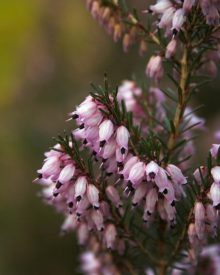 Heather is used for magick involving maturity, consummation, general luck, love, ritual power, conjuring ghosts, healing, protection, rain-making and water magick. Charms made with Heather can be worn or carried as protection against danger, rape and other violent crimes.
Heather is used for magick involving maturity, consummation, general luck, love, ritual power, conjuring ghosts, healing, protection, rain-making and water magick. Charms made with Heather can be worn or carried as protection against danger, rape and other violent crimes.
This flower represents good fortune and Heather can also be carried as a lucky charm. It was believed that wearing the blossom associated with your month of birth would bring exceptionally good luck – therefore people born in the month of Heather (August) should carry White Heather, for even better luck throughout the year.
Legend has it that a gift of white Heather brings luck to both the giver and the receiver, whereas red Heather is said to have been colored by heathens killed in battle by Christians, so is less lucky.
Heather is associated with secrets from the Otherworld. A sprig of white Heather placed in a special place of silence and meditation has the power to conjure ghosts, haints or spirits.
After picking a piece of white Heather at midnight, place it in a glass of river water in the darkest corner of your home. Sit and think of a departed loved one and it is said that the loved ones shadow will visit you.
Heather is said to ignite faery passions and open portals between their world and our own. Heather represents solitude because it thrives in wide open spaces, and Faeries who enjoy living in such undisturbed places are said to feast on the tender stalks of Heather. The Fae of this flower are drawn to humans who are shy.
Heather is useful for Solitary healing work (going within). Heather, if used along with Mistletoe, creates powerful healing medicine in both spiritual and physical aspects.
Heather can be used at Midsummer to promote love – carry red Heather for passion or white Heather for cooling the passion of unwanted suitors. If you give someone a gift of Heather it means: ‘Admiration’. A charm bag filled with Heather can be carried for decreasing egotism or self-involvement.
As a water herb, Heather is very useful in weather magick. When burned outdoors with Fern, the herbal smoke of Heather attracts rain. Bouquets of Heather and Fern can also be dipped in water to call rain.
Recommended Reading:
- Year of Moons, Season of Trees
- Tree Medicine Tree Magic
- A Druid’s Herbal
- Celtic Astrology
- Glamoury: Magic of the Celtic Green World
- The Book of Druidry
Source: dutchie.org
- Common names: Thoroughfwort, White Snake Root, Agueweed, Indian Sage
- Scientific name: Eupatorium perfoliatum
- Element: Water
- Planet: Saturn:
- Parts Used: Leaf
Boneset guides ghosts elsewhere, attracting protective, benevolent spirits instead. Boneset may also be used to protect people and animals from “ghost sickness,” the illness that some believe may emerge after extended contact with the dead.
The most potent boneset is found growing on or near graves. Supplement it with white pine for added enhancement.
Hang fresh boneset branches over doorways, or burn young boneset branches and twigs within a cauldron to drive away existing ghosts.
In addition to it’s ghost busting power, boneset opposes unnatural illness and snakes.
To counteract occult poisons they have been fed, folks rub dry boneset leaves all over their body, then take the leaves outdoors and burn them with a holy or purifying incense.
Brew boneset leaf tea and bathe in it to get rid of enemy tricks that have affected your health. Boneset can also be used to purify a sickroom by sprinkling it onto the floor and then sweeping it out the front door.
Burn boneset in an Incense to balance the energies of a space or to ground and focus your energy. Added to an Elixir or Philtre, boneset promotes health. Mixed with angelica and added to the bath, boneset is excellent for ritual cleansings.
From: The Element Encyclopedia of 5000 Spells
And: Hoodoo Herb and Root Magic and other sources
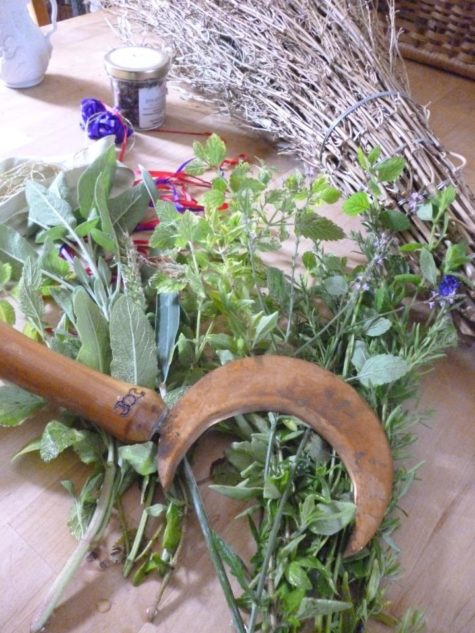
In traditional herbal magick there are nine steps to gathering herbs. They are as follows:
First the herb must always be taken with the left hand. This is because the left hand is receptive. When the power of an herb is harvested it is received and not taken.
Second, the wind (if any) must be at your back when the herb is gathered. This is because the wind indicates the presence of spirits and to have them support you from behind is beneficial. To have them pushing against your movements is detrimental and you risk offending them. In other words you are either with the flow or against the flow.
Third, you must never look back over your shoulder. This is because you might scare off the fairy folk and other nature spirits who have gathered to take witness. Thus abandoned, you risk negative charges on the herb.
The fourth step in harvesting an herb is to trace a circle around the herb with your magickal blade. This prepares the spirit of the herb for withdrawing and ensures that it stays with the herb when harvested. It is essential that iron never come in contact with the herb or touch inside the circle at any time. Iron negates magickal magnetic charges.
The fifth step requires that you speak to the herb telling it why you need its help and what you are about to do to it.
The sixth step is to place the herb in a pouch, never letting it touch the soil. If it touches the soil the spirit will pass back into the soil.
The seventh step is to wear no jewelry or clothing and to have abstained from sexual intercourse for seven days (a lunar quarter). This helps to magnetize your aura, and being nude while you gather the herb makes you a creature of Nature again free from the signs of domestication.
The eighth step is to leave a small gift or offering in the hole from where the herb was withdrawn. The traditional offering is a mixture of equal parts of wine, honey, and milk. In place of this, a silver or copper coin may be planted as a gift to the Earth spirit. Perhaps the best offering might well be a new herbal seed.
The ninth and final step is to kiss your hand to the moon as a token of love and respect.
Notes:
When taking an herb in this manner you will want to decide in advance whether you need the entire plant or simply a leaf or two. The leaves will only provide you with pharmaceutical ingredients, as would only the roots or stems. To obtain the spirit of the plant you must harvest the entire plant intact. If you harvest only the leaves of an herb then avoid pouring the libation directly upon the plant. If using a coin simply press it into the soil nearby.
If harvesting wild plants leave a large amount of flowers, seed and root as the plant population of that area will very quickly die out if you go in mob-handed and wrench up the only two plants for miles around.
Source: Wiccan Magick
